Section Topics
Overview of InterAction Word Processor Integration
InterAction provides tools you can use from within Microsoft Word. This gives you access to contact names, phone numbers, and addresses stored in InterAction.
In Word, these buttons are provided in multiple locations on the Word Ribbon:
- All of the buttons are available on the InterAction tab.
- The Mail Merge, Envelope, and Label buttons are also on the Mailings tab.
- The Insert Contact button is also on the Insert tab.

InterAction Buttons in Word Ribbon, Word
[A] The InterAction tab with all of the InterAction buttons available in the Insert, Mailings, and General groups.
[B] The Insert Contact button is available in the InterAction group on the Insert tab.
[C] The Mail Merge, Envelope, and Labels buttons are available in the InterAction group on the Mailings tab.
You can use the InterAction Tools to do any of the following:
-
Launch the Web Client. See Launching the Web Client from Your Word Processor .
-
Look up a contact in InterAction and insert information in a document. For example, when writing a letter you can look up a contact by name and insert his or her business address.
-
Look up a contact and create an envelope with the contact’s address.
-
Look up a contact and create labels with the contact’s address.
-
Find a set of contacts and perform a mail merge to create letters, labels, or other lists of contacts in Word.
For general information about using these tools, see the following topics:
- How Your Word Processor Communicates with InterAction
- Entering Search Criteria in the Find Contact Dialog Box
- Selecting the Contact Data to Use
How Your Word Processor Communicates with InterAction
Microsoft Word can use InterAction Desktop Integration to communicate with InterAction. InterAction Desktop Integration consists of several components that can be used to integrate InterAction with common desktop tools. Available components include the following:
- InterAction Desktop Tools
- InterAction Add-in for Outlook
- Word Processor Integration
Your system administrator can install these components on your computer if needed. To use integration with Microsoft Word described here, you need the Word Processor Integration component. This installs the InterAction Tools toolbar.
Note: The Desktop Integration components are installed as part of the Desktop Applications component.
The integration is accomplished via the use of InterAction Objects. Programmers and macro developers can use InterAction Objects to access InterAction data programmatically. Your organization may provide additional custom integration using this technology.
Entering Search Criteria in the Find Contact Dialog Box
The first step for using the InterAction tools in Word is to find a contact or set of contacts. The Find Contact dialog box has tabs for the different types of contact lists you can search.
The four main tabs (My Contacts, Firm List, Marketing Lists, and Working Lists) each include the First Name, Last Name, and Company search fields. Additional options differ for each tab. The tabs available for Related Modules (Matters, Opportunities, or Engagements) are completely different and do not include the name fields.
My Contacts
When you choose the My Contacts tab, InterAction only looks for contacts in your contact list. Note the following:
- You can leave all the criteria fields blank and choose Search to see your entire list. This is similar to viewing the My Contacts page in the Web Client.
- This tab includes a Category drop-down list. This contains all of the categories you have created for your contact list.
- To see all the contacts in a category, select it and then leave the name fields blank.
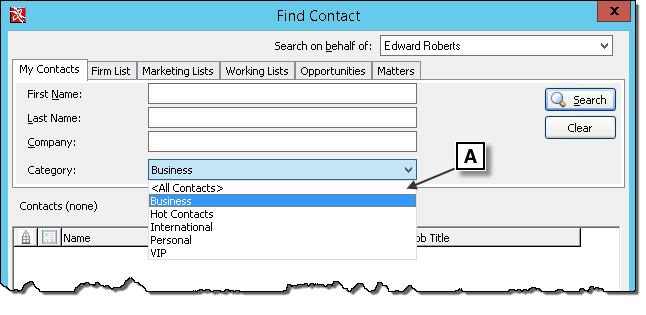
[A] Select a category. This drop-down list includes all categories you have defined for your contact list.
Firm List
When you choose the Firm List tab, InterAction searches across all of InterAction. Note the following:
- You must enter criteria in at least one field before choosing Search.
-
This tab includes a Contact Type drop-down list. This contains all of your frequently used contact types. If you want to search a contact type not shown in the list, choose Find to look up the contact type.
For details about defining your frequently used contact types in the Web Client, see My Frequently Used Lists.
- To see all the contacts assigned a contact type, select it and then leave the name fields blank.
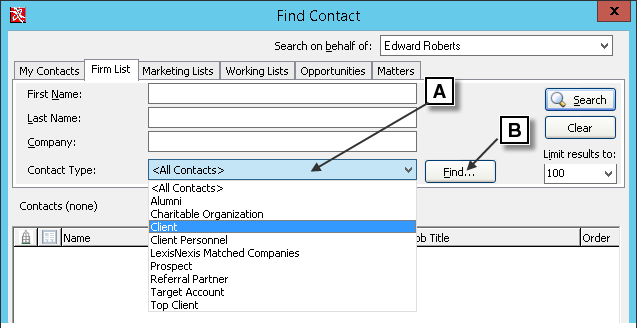
Firm List Tab
[A] Select a contact type. This drop-down list contains all of your frequently used contact types.
[B] Choose Find to look up a contact type not shown in the drop-down.
Marketing Lists
When you choose the Marketing Lists tab, InterAction searches a single marketing list at a time. Note the following:
- You must select a list from the Marketing List drop-down. You cannot leave this blank.
-
The Marketing List drop-down list contains all of your frequently used marketing lists. If you want to search a list not shown, choose Find to look up the marketing list.
For details about defining your frequently used marketing lists in the Web Client, see My Frequently Used Lists.
-
To see all the contacts in a list, select it and then leave the name fields blank.
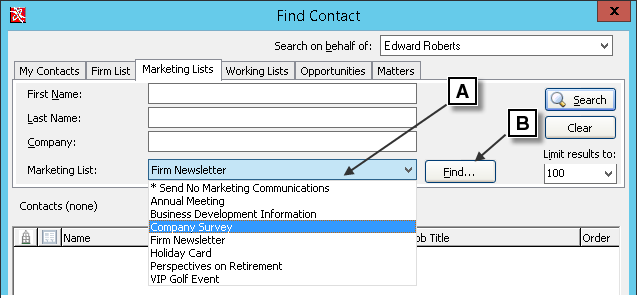
[A] Select a marketing list. This drop-down list contains all of your frequently used marketing lists.
[B] Choose Find to look up a marketing list not shown in the drop-down.
Working Lists
When you choose the Working Lists tab, InterAction searches a single working list at time. Note the following:
- You must select a list from the Working List drop-down. You cannot leave this blank.
-
The Working List drop-down list contains all of your frequently used working lists. If you want to search a list not shown, choose Find to look up the marketing list.
For details about defining your frequently used working lists in the Web Client, see My Frequently Used Lists.
-
To see all the contacts in a list, select it and then leave the name fields blank.
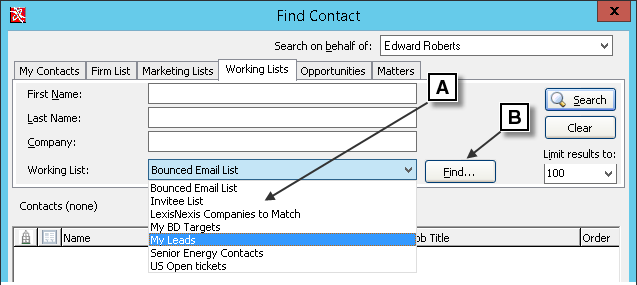
[A] Select a working list. This drop-down list contains all of your frequently used working lists.
[B] Choose Find to look up a working list not shown in the drop-down.
Matters, Opportunities, or Engagements
When you choose a tab for one of the Related Modules, InterAction searches the contact list for a single matter, opportunity, or engagement. Note the following:
- This tab does not include the name fields.
- You must select the matter, opportunity, or engagement from the first drop-down list. You cannot leave this blank.
-
The first drop-down list contains all of your frequently used items for the module. If you want to search an item not shown, choose Find to look up the matter, opportunity, or engagement.
For details about defining your frequently used working lists in the Web Client, see My Frequently Used Lists.
-
The Show drop-down list contains the following subsets of contacts for the selected matter, opportunity, or engagement:
-
Key Contacts
-
Each distribution list defined for the item
-
Important roles as defined by your organization
-
Contacts Without Roles
-
Contacts Not on a Distribution List
-
-
If you have sufficient access rights, you can create and edit the distribution lists for the item. Choose Actions > Manage <Module> Distribution Lists.

Matters / Opportunities / Engagements Tab
[A] Select the matter, opportunity, or engagement. This drop-down list contains all of your frequently used items for the module.
[B] Select the list of contacts you want to view for the item.
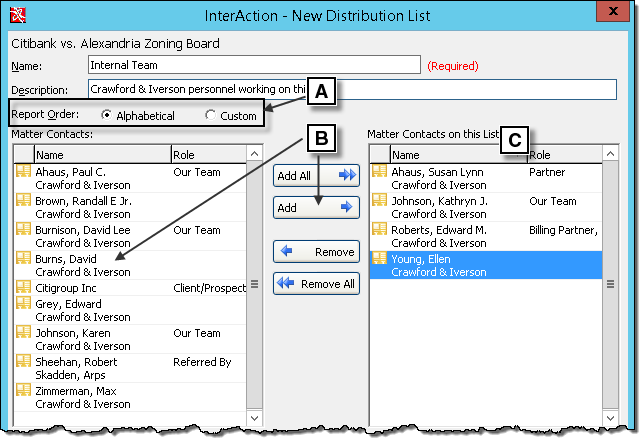
[A] You can select whether the distribution list displays in alphabetical or custom order. If you select Custom, you can run a mail merge in the specified order.
[B] Contacts on the matter, opportunity, or engagement appear here. Select one or more contacts and choose Add to include them on the list.
You can also Add All and Remove All.
[C] This displays the contacts on the distribution list.
Selecting the Contact Data to Use
Contacts in InterAction can have two different versions of phones and addresses: the information stored with your version of the contact and the information stored with the firm’s version. This information can be different; for example, your version of a contact might have a home address, while the firm version has just the work address.
When you use the Word tools to insert contact data or run a mail merge, InterAction needs to choose which version of the information to use. You can set a preference to designate which version to use when you search for contacts from the Firm List, Marketing Lists, and Working Lists tabs. There are two options:
-
Always use your version. In this case, your version of the information is used for all the contacts that are in your contact list. For contacts not in your list, the firm’s version is used.
-
Always use the firm’s version.
Note: When you search from the My Contacts tab, your information is always used, regardless of the preference selected here.
Also note that the firm’s information may be available to all users or it may be available only to users with access to a particular list. For details about list-specific phones and addresses, see Creating List-Specific Phones and Addresses.
Select the Version of Contact Data to Use
You set this option when searching for contacts. You can change it whenever necessary. For example, for one mail merge you might want to use your own version, while for a different merge you want to use the firm’s version.
-
In Word, choose it insert a contact or start your Envelope, Label, or Mail Merge.
See one of the following:
-
In the dialog box for finding the contact or contacts to use, choose Actions > Preferences.
-
In the Search Preferences dialog box, select either Always use my version or Always use the Firm version.
-
Choose OK.
-
Fill in your search criteria and continue finding the contact or contacts.
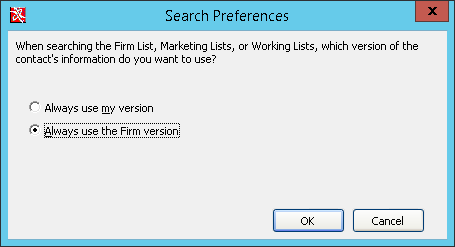
Selecting the Data for Envelopes, Labels, and Mail Merge
